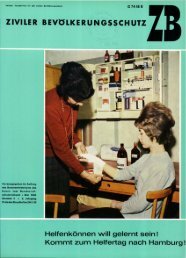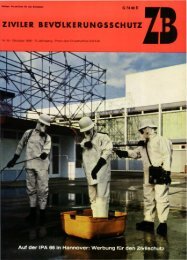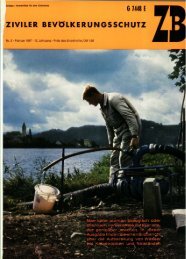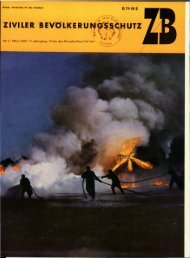Zivilschutz- Forschung - Bundesverwaltungsamt
Zivilschutz- Forschung - Bundesverwaltungsamt
Zivilschutz- Forschung - Bundesverwaltungsamt
Sie wollen auch ein ePaper? Erhöhen Sie die Reichweite Ihrer Titel.
YUMPU macht aus Druck-PDFs automatisch weboptimierte ePaper, die Google liebt.
91. Kasthuri, A. S., A. B. Pradhan, et al. (1990). „Nuclear, biological and chemical<br />
warfare. Part II: Medical aspects of biological warfare.“ J Assoc Physicians<br />
India 38(5): 356-7.<br />
92. Katzman, S. (2000). „Preparing for the worst. The USA and Japan's preparations<br />
for a terrorist attack with chemical or biological weapons.“ EMBO<br />
Rep 1(5): 387-9.<br />
93. Kennedy, F., A. Whitehead, et al. (1994). „Chemical emergencies and the<br />
Health Advisory Group on Chemical Contamination Incidents (HAGCCI).“<br />
Health Trends 26(4): 106-8.<br />
94. Kirk, M. A., J. Cisek, et al. (1994). „Emergency department response to<br />
hazardous materials incidents.“ Emerg Med Clin North Am 12(2): 461-81.<br />
95. Kirk, M. A., J. Cisek, et al. (1994). „Emergency department response to<br />
hazardous materials incidents.“ Emerg Med Clin North Am 12(2): 461-81.<br />
96. Knudson, G. B. (1991). „Operation Desert Shield: medical aspects of weapons<br />
of mass destruction.“ Mil Med 156(6): 267-71.<br />
97. Kociolek, K. T. (1996). „[State Fire Services in rescuing people injured in<br />
chemical accidents and disasters].“ Przegl Lek 53(4): 387-9.<br />
98. Koehler, G. A. and C. Van Ness (1993). „The emergency medical response<br />
to the Cantara hazardous materials incident.“ Prehospital Disaster Med 8(4):<br />
359-65.<br />
99. Koplan, J. P., H. Falk, et al. (1990). „Public health lessons from the Bhopal<br />
chemical disaster.“ Jama 264(21): 2795-6.<br />
100. Koscheyev, V. S., G. R. Leon, et al. (1997). „Lessons learned and unsolved<br />
public health problems after large-scale disasters.“ Prehospital Disaster Med<br />
12(2): 120-31.<br />
101. Kourniotis, S. P., C. T. Kiranoudis, et al. (2000). „Statistical analysis of domino<br />
chemical accidents.“ J. Hazard Mater 71(1-3): 239-52.<br />
102. Krenzelok, E. P., M. P. Allswede, et al. (2000). „The poison center role in<br />
biological and chemical terrorism.“ VET HUM TOXICAL 42(S): 297-300.<br />
103. Kulling, P. (1996). „Special features of chemical accidents.“ Przegl Lek<br />
53(4): 216-9.<br />
104. Kulling, P. E. and H. Lorin (1999). „KAMEDO – a Swedish Disaster Medicine<br />
Study organization.“ Prehospital Disaster Med 14(1): 18-26.<br />
105. Kuntz, E. (1979). „Ready to evacuate area? Nuclear and chemical accidents<br />
test hospital disaster plans.“ Mod Healthc 9(5): 14-5, 19.<br />
106. Landesman, L. Y. and R. B. Leonard (1993). „SARA three years later. Emergency<br />
physician's knowledge, beliefs, and actions.“ Prehospital Disaster Med<br />
8(1): 39-44.<br />
107. Landesman, L. Y., S. B. Markowitz, et al. (1994). „Hospital preparedness for<br />
chemical accidents: the effect of environmental legislation on health care services.“<br />
Prehospital Disaster Med 9(3): 154-9.<br />
108. Laurent, J. F., F. Richter, et al. (1999). „Management of victims of urban chemical<br />
attack: the French approach.“ Resuscitation 42(2): 141-9.<br />
227

















